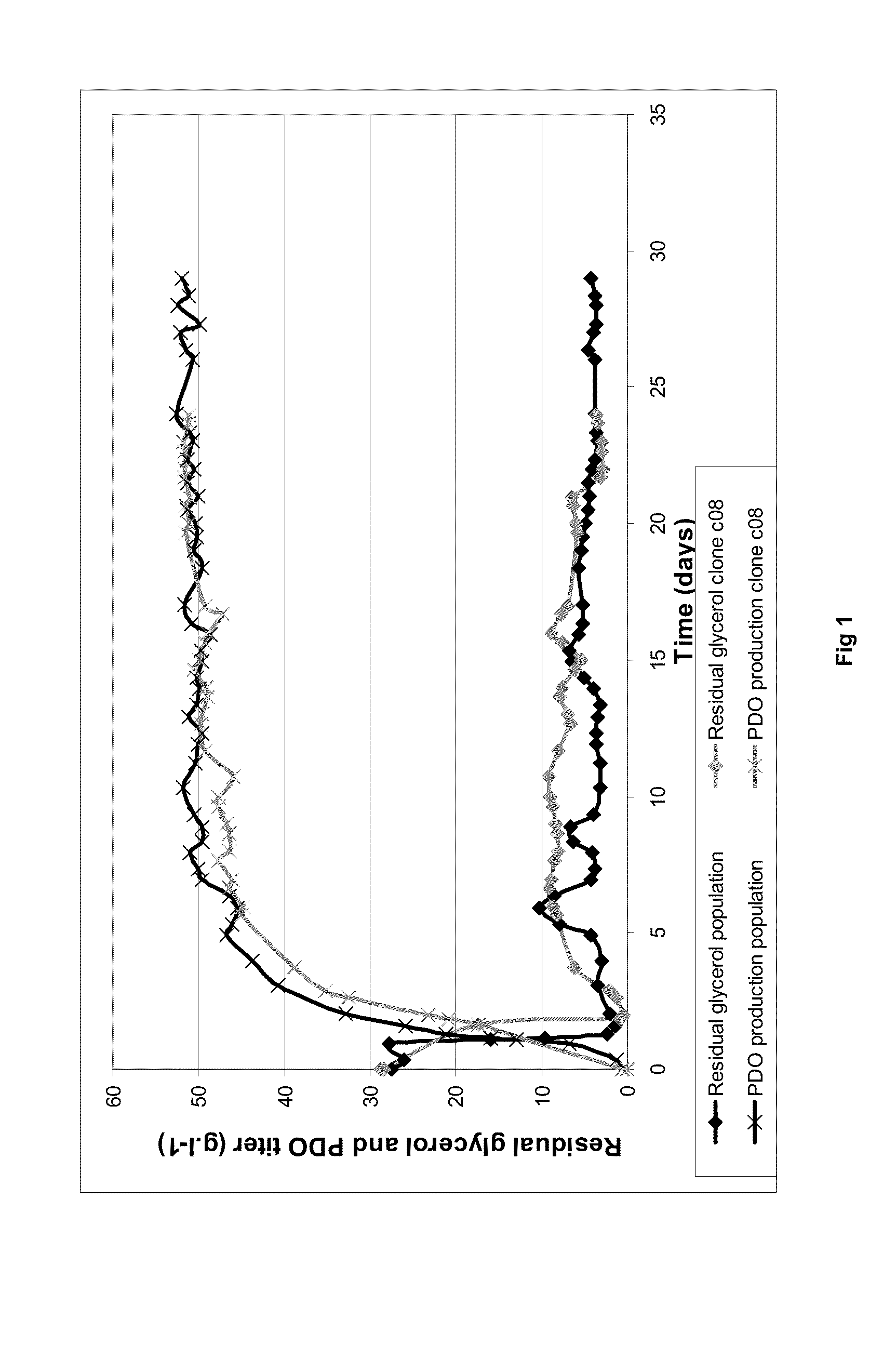Microorganisms for 1,3-propanediol production using high glycerine concentration
a technology of glycerine concentration and microorganisms, which is applied in the field of microorganisms for 1, 3propanediol production using high glycerine concentration, can solve the problems of high production cost, inability to compete with petrochemically available diols, and use of vitamin b12, which is a very expensive cofactor
- Summary
- Abstract
- Description
- Claims
- Application Information
AI Technical Summary
Benefits of technology
Problems solved by technology
Method used
Image
Examples
example 1
Isolation of Clones from the Evolved Population
[0054]Clone isolation was performed on agar plates starting from a growing flask culture of the population strain Clostridium acetobutylicum DG1 pSPD5 PD0001VE05. The synthetic media used for flask culture contained per liter of deionized water:glycerine, 30 g; KH2PO4, 0.5 g; K2HPO4, 0.5 g; MgSO4, 7H2O, 0.2 g; CoCl2 6H2O, 0.01 g; acetic acid, 99.8%, 2.2 ml; NH4Cl, 1.65 g; MOPS, 23.03 g, biotin, 0.16 mg; p-amino benzoic acid, 32 mg; FeSO4, 7H2O, 0.028 g; resazurin, 1 mg and cysteine, 0.5 g. The pH of the medium was adjusted to 6.5 with NH4OH 6N.
[0055]Different media were used for isolation on agar plates:synthetic agar medium (the same as described above) with either commercial glycerine or raw glycerine and CGM (Clostridial Growth Medium) agar medium which contains per liter of deionized water:commercial or raw glycerine, 30 g; yeast extract, 5 g; KH2PO4, 0.75; K2HPO4, 0.75 g; MgSO4, 7H2O, 0.4 g; asparagine, 2 g; (NH4)2SO4, 2 g; NaCl, 1...
example 2
Performances of Clone c08 in a Chemostat Culture with High Concentrations of Raw Glycerine
[0068]Isolated clone of C. acetobutylicum strain DG1 pSPD5 PD0001VE05 (strain was 1 / cured from pSOL1 2 / transformed with plasmid pSPD5 harbouring dhaB1, dhaB2 and dhaT genes, ie 1,3-propanediol operon, and 3 / evolved on high concentrations of raw glycerine). The isolation protocol was described in example 1.
Culture Media:
[0069]The synthetic media used for clostridia batch cultivations contained per liter of deionized water: glycerine, 30 g; KH2PO4, 0.5 g; K2HPO4, 0.5 g; MgSO4, 7H2O, 0.2 g; CoCl2 6H2O, 0.01 g; H2SO4, 0.1 ml; NH4Cl, 1.5 g; biotin, 0.16 mg; p-amino benzoic acid, 32 mg and FeSO4, 7H2O, 0.028 g. The pH of the medium was adjusted to 6.3 with NH4OH 3N. Commercial glycerine purchased from Sigma (purity 99.5%) was used for batch cultivation. The feed medium for continuous cultures contained per liter of tap water:raw glycerine, 105 g; KH2PO4, 0.5 g; K2HPO4, 0.5 g; MgSO4, ...
example 3
Genomic DNA Extraction
[0078]Genomic DNA from strains PD0001VT, PD0001VE05, PD0001VE05c01, PD0001VE05c05, PD0001VE05c07 and PD0001VE05c08 was extracted using Qiagen Genomic kit 500G (Qiagen, Inc., Valencia, Calif.). Briefly, cells were grown anaerobically respectively in rich or synthetic glycerine medium (as described in example 1 and 2) in penicillin vials (70 mL) to late exponential phase (A620 1.5 to 2.0). Strictly anaerobic conditions were maintained throughout cell lysis. Cells were collected and washed twice in SET buffer (25% sucrose, 0.05 M Tris-HCl, 0.05 M EDTA). Cell pellets were suspended in 11 mL B1 kit buffer with 44 μL RNase, 30 mg / mL lysozyme and 100 μg / mL proteinase K. The mixtures were incubated at 37° C. for 45 min, centrifuged and supernatants were used for DNA extraction according to the Qiagen DNA purification kit instructions. The DNAs were then suspended in 50 μL of 10 mM Tris-HCl (pH8.0).
Sequencing Analysis
[0079]Genomes of the native DG1 pSPD5 PD0001VT strain...
PUM
| Property | Measurement | Unit |
|---|---|---|
| Concentration | aaaaa | aaaaa |
| Concentration | aaaaa | aaaaa |
| Temperature | aaaaa | aaaaa |
Abstract
Description
Claims
Application Information
 Login to View More
Login to View More - R&D
- Intellectual Property
- Life Sciences
- Materials
- Tech Scout
- Unparalleled Data Quality
- Higher Quality Content
- 60% Fewer Hallucinations
Browse by: Latest US Patents, China's latest patents, Technical Efficacy Thesaurus, Application Domain, Technology Topic, Popular Technical Reports.
© 2025 PatSnap. All rights reserved.Legal|Privacy policy|Modern Slavery Act Transparency Statement|Sitemap|About US| Contact US: help@patsnap.com

